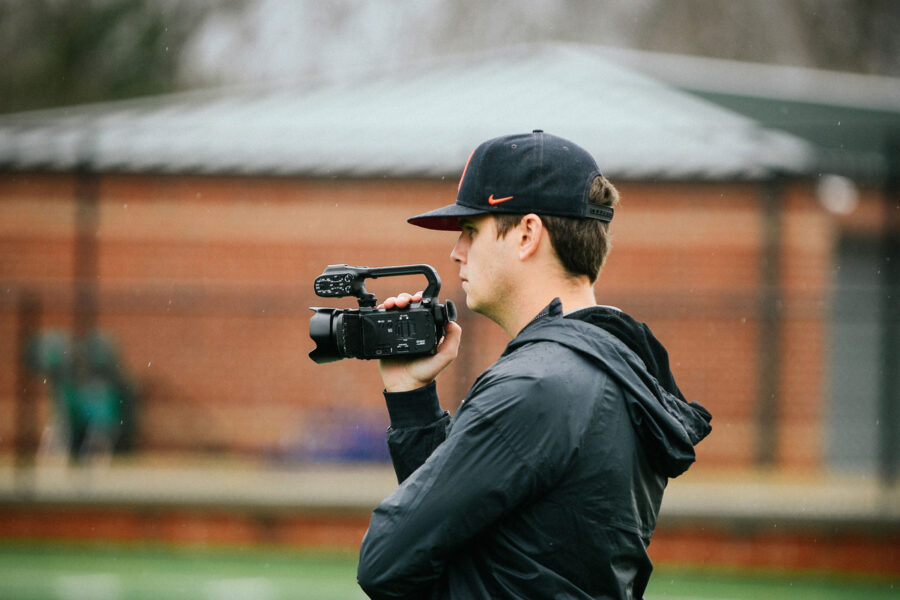It’s better to see a wrong step in August and correct it right away than to try nipping a bad habit during state playoffs.
The following is a guest post from Steve Standefer, Video Coordinator at Oak Ridge High School in Conroe, Texas.
Our philosophy regarding video is “That eye in the sky don’t lie!” We film everything and take pride in our filming procedures. It’s better to see a wrong step in August and correct it right away – or even the next day – than to try nipping a bad habit in December when that state championship is on the line. And even if you don’t see your mistakes, somebody else will.
Additionally, we can coach until we’re blue in the face and our kids will not believe a word we say until they see it on film. Once they do, that light bulb goes off in the ultimate ah-ha moment.
But how can anyone get that much filming done on a daily basis? Put together a video crew and make them an equal part of the team, with the chance to earn their own varsity letters. They can even go through a recruiting process of their own – contacting major universities in search of videographers. Just be sure their importance never goes unacknowledged. The little things you do to appreciate a job well done will foster a crew willing to go above and beyond, which is often what it takes to get the right amount of footage.
Practice
We film and upload everything on a daily basis. The same video crew that works each game is also responsible for setting up practice. This is a great time for everyone to work on their assembly skills and troubleshoot any technical difficulties prior to filming. During setup, everyone reviews the practice schedule that all coaches have to follow, so we know exactly when to film drill segments, inside, 7-on-7, and offensive/defensive workouts.
Our practice workflow requires four cameras: two end zone cameras (one on each field) and two sideline cameras atop a 20’ tower between the offensive and defensive fields.
We also use kids at ground level to film quarterback drops, ball placement, and other daily drills at that position. During practice, the crew keeps a close eye on the segment clock to track each workout’s duration and anticipate their next task.
Post-Practice
During teardown, one student videographer visits each station to round up the day’s SD cards. We then take those cards to the video room equipped with four Intel i7 computers and begin the upload process.
We aim to have all practice segments uploaded, tagged, cut up and shared with everyone – coaches and athletes – by the time they get out of the shower. Because each camera has only filmed a few segments a piece, the uploads are fairly quick.
Game Night
I have two upper-level kids assigned to official game footage – tight, wide and end zone. Four others film game highlights from the four corners of the field – those are the fun assignments. They film everything from the team taking the field to kickoff, and every snap until the final down. They stick to their zones for the sake of capturing ground level highlights.
We also assign two junior high coaches to tag and spot with Hudl’s Tag a Game tool (via the free iOS app). It’s a great feature to track the game – we highly recommend it. This is the second year we’ve used it and it’s only gotten better.
Post-Game
The end of a game is just like practice. My guys make sure to get the SD cards to me immediately, then break down their own equipment.
I make it in before the team and immediately begin uploading only the official game footage (tight, wide and end zone). Usually by the time I’ve started each upload, the kids are gone. After a brief staff meeting, I head home to find everything uploaded. No more waiting until 4:30 in the morning! It has been five years since I slept at the fieldhouse, tracking an upload’s progress.
Once everything is posted on Hudl, I rename the files with their respective angles. I then copy all three angles, intercut the copies and rename that film Combined Angles. It’s important to make sure the angles truly match before saving – syncing the timestamps on your cameras plays a huge role in this step.
I then align the Tag a Game data (uploaded from the iPad) and match it accordingly. Be sure to check a few random plays to make sure the down, distance, etc., is correct.
This is all done by 8 a.m. Saturday. Luckily, I can do it from home, so everything is ready before the rest of the staff arrives for film grading and opponent scout breakdown the next morning.
We have started this same video program with several other sports, including volleyball, basketball, baseball, softball, soccer, wrestling and track. Tennis and golf have also asked to join the program next year. They are all starting to see the benefits in having Hudl on their side.
To anyone considering making the jump from your current program and coming on to Hudl, it’s an easy transition and well worth it. If you are not using Hudl daily and to its fullest, then you are losing championships.
